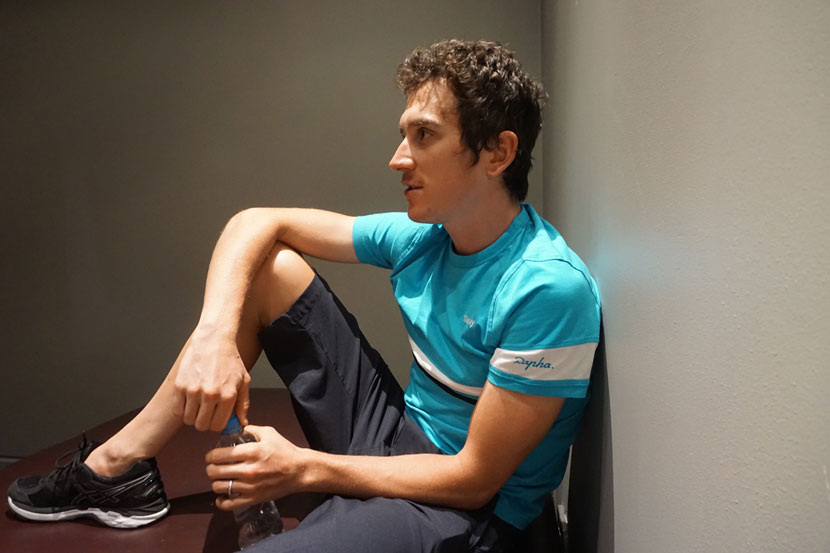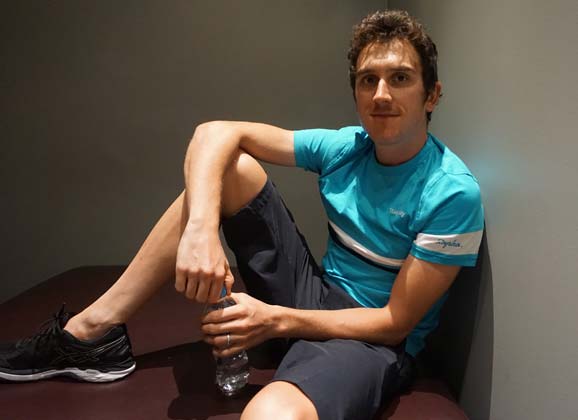[et_pb_section bb_built=”1″ admin_label=”section”][et_pb_row background_position=”top_left” background_repeat=”repeat” background_size=”initial”][et_pb_column type=”1_4″][et_pb_text background_layout=”light” text_orientation=”left” use_border_color=”off” border_color=”#ffffff” border_style=”solid” background_position=”top_left” background_repeat=”repeat” background_size=”initial”]
Geraint Thomas has achieved a lot as a cyclist already but he believes there’s a lot more yet to come. After the London Olympics, RIDE spoke to him about his accomplishments as a track cyclists and what he expects will come next.
This is an interview done on 21 January 2016.
[/et_pb_text][/et_pb_column][et_pb_column type=”3_4″][et_pb_text use_border_color=”off” background_position=”top_left” background_repeat=”repeat” background_size=”initial” _builder_version=”3.12″]
Geraint Thomas explained that finishing his first Tour de France tested his willpower more than just about anything in his riding career. But now he’s aiming to finish on the podium.
“I now definitely think, ‘Why not?’” he said a few years ago.
“I don’t think, ‘No, I can’t do that.’”
– Geraint Thomas interview: Part 02 –
[/et_pb_text][/et_pb_column][/et_pb_row][et_pb_row admin_label=”row” background_position=”top_left” background_repeat=”repeat” background_size=”initial”][et_pb_column type=”4_4″][et_pb_text background_layout=”light” text_orientation=”left” use_border_color=”off” border_color=”#ffffff” border_style=”solid” background_position=”top_left” background_repeat=”repeat” background_size=”initial”]
We caught up with ‘G’ again after stage one of the 2016 Tour Down Under to talk about his hopes for the season, how he manages his responsibilities and why cycling still means a lot to him 10 years into his pro racing career.
Click the SoundCloud file to listen to part one of his discussion with Rob Arnold and/or read the transcript below.
[/et_pb_text][/et_pb_column][/et_pb_row][et_pb_row background_position=”top_left” background_repeat=”repeat” background_size=”initial”][et_pb_column type=”1_4″][/et_pb_column][et_pb_column type=”3_4″][et_pb_text use_border_color=”off” background_position=”top_left” background_repeat=”repeat” background_size=”initial” _builder_version=”3.12″]
Geraint Thomas Q&A – Part 01
RIDE:We had a long chat a couple of years ago when we talked about pursuiting largely. Remember…? And I hate to do it to you in January, but we’re going to talk about July, if that’s alright because I’m sure that’s what you’re used to now.
Should we just rip straight into it?
Geraint Thomas: “Yeah.”
First of all, three years ago when we were talking you still had track legs. You don’t anymore. How can you paraphrase, or summarise, the body shape change?
“Yeah, it’s big.
“Obviously, on the track you don’t even have to worry about weight. It’s all about power and getting protein in… some days you do maybe less than four kilometres on the track but it’s all intense, powerful, explosive stuff and you can do all the muscle damage and you still have to take on your food and proteins and recover for the next day.
“It’s just that you bulk up and obviously you get more fat as well.
“So, yeah, since leaving the track each year I’ve managed to get a little bit lighter.
“I think those track years certainly helped prolong my road career in a way because I still feel mentally really fresh. I’m still changing my program slightly as well where as, say, [Ian] Stannard – every year as a pro now he’s probably ridden a Grand Tour and done the Classics, he’s had the big sort of intense, real hard years with 70 or 80 days of racing.
“For myself, I kind of feel like those track years… they were still hard and I still obviously rode Grand Tours but there was still a lot less [racing] and it wasn’t as intense and sustained. I think that helps as well, massively.
“But yeah, the weight thing is the hardest…
“I find it easy to go out and train; I just do that and I enjoy that. I really love it so the hardest bit is the food because, [it’s there] 24/7 and you can’t just switch off from it. You’re constantly thinking about it.
“You’re constantly thinking, ‘Oh, I’m pretty hungry now, I could eat this or that…’
“You’re always craving the bad stuff and the grass it always greener…
“But then that’s why [I have] the little blow-outs I have.
“So, after Romandie [in 2015] or after the Classics in the past, I’ve had a week off where I can go out for a few meals and have a few drinks. And then obviously in the off-season then you make the most of that for sure.
“But as soon as you’ve had two weeks off, you’re kind of like, ‘Oh, I feel unhealthy and I want that routine now and that healthy living again…’”
Where do you feel unhealthy? Is it cardiovascular…?
“Everything. You’ve usually got a sore head from a few too many drinks and you feel bigger… your insides just don’t feel healthy and clean.
“You’re so used to eating really good and healthy food: rice and quinoa, chicken, salads… and training like 20-30 hours a week, to doing nothin’ and eating burgers and pizzas and just feeling really sluggish and lethargic.
“It made me think. This year was the first time I thought, ‘Bloody hell, when I stop, I’m going to need some sort of goal…’ because [if I didn’t] I’d end up like Allan Davis within six months I think.”
[/et_pb_text][/et_pb_column][/et_pb_row][et_pb_row background_position=”top_left” background_repeat=”repeat” background_size=”initial”][et_pb_column type=”4_4″][et_pb_text background_layout=”light” text_orientation=”left” use_border_color=”off” border_color=”#ffffff” border_style=”solid” background_position=”top_left” background_repeat=”repeat” background_size=”initial”]

[/et_pb_text][/et_pb_column][/et_pb_row][et_pb_row background_position=”top_left” background_repeat=”repeat” background_size=”initial”][et_pb_column type=”1_4″][/et_pb_column][et_pb_column type=”3_4″][et_pb_text use_border_color=”off” background_position=”top_left” background_repeat=”repeat” background_size=”initial” _builder_version=”3.12″]
I was going to talk to you about this eating disorder piece that we published earlier last year. There’s so much obsession about weight in the pro ranks and then that filters through the magazine – where I’m [for example] having a discussion with you about your eating. And you’re saying, the hard part is resisting that natural hunger. But you’re also saying, when you do cave into that hunger, you feel shit. So you can feel shit and you can feel shit… the grass is always greener isn’t it?
“Yeah, for sure. It is like genuinely an issue, I think, for some people.
“Myself, I can go out and have a meal – have a steak or something, an ice-cream – and I’ll just be like, ‘Oh, yeah… it’s okay it’s just a once-a-week…’ and I won’t beat myself up about it. Whereas some guys probably would.
“I think it’s teams managing that which is is quite key to their health as well, really.
“It’s such a big issue.
“A kilo in a Grand Tour could make a difference from being top 10 overall, to being outside the top 20.
“For me this year it’s kinda like I want to get to that next level again and that will be the main factor, really, with it.
“Obviously the whole training more specifically for climbs, and threshold, and all this and that… but, at the same time, being a kilo lighter than I was last year – which is kind of like the target at the moment. I think it will make a big difference.”
Can you just talk me through those numbers? When we were talking about it a few years ago, you were saying, ‘I want to lose five or six kilos and sort of follow the lead of Wiggo…’ You’ve done that, I would imagine.
“At the Tour [in 2015] I was around 68kg.”
And off the track?
“Off the track? Oh, I was big, I must have been something like around 74, 75 probably on a big day.”
So it is quite dramatic; when you’re already lean. I mean, on the track it’s not like you were Homer Simpson… you were lean and you looked fit but your legs [now] look super skinny. To me it strikes me as the obvious physical difference.
“Yeah. I think the constant riding… a lot more miles, just training purely on the road the whole time, you just lose weight anyway.
“Even if I didn’t watch my diet I reckon I’d easily been down to 71, just by riding my bike more and cutting back a bit but just doing more volume, and a [different] style of training – low intensity – you burn more fat anyway just because of that.
“I’d be a lot leaner anyway but then when you really knuckle down and you work with nutritionists and you really sort of plan what you’re eating and things, it comes off even more.
“I was saying early, it’s kind of infectious though. And that’s when it can go bad because you think, ‘Oh, I want to keep going… keep going!’
“Or, ‘Oh, I’m 68 today and feel good so why can’t I be 67 or 66?’
“And there is a point where it will all just fall away.
“It’s like when you’re training and you feel really good, so you go, ‘Oh, I’ll do another hour today’, or ‘I’ll do another effort today…’ and suddenly a week later you go over that edge and you’re nailed and you’re knackered and you go to a race and don’t do as well.
“It’s a knock-on effect and it’s a similar thing with weight, I think.
“It’s about being just able to have the confidence to hold back and no do as much.
“More isn’t always better.
“You have to rest.
“And that’s why Tim [Kerrison] is really good with me. That’s biggest influence he’s had with me. He obviously pushes you and takes you to that limit but at the same time he has to hold me back sometimes as well and keep me from, like I say, going over that edge.”
[/et_pb_text][/et_pb_column][/et_pb_row][et_pb_row background_position=”top_left” background_repeat=”repeat” background_size=”initial”][et_pb_column type=”4_4″][et_pb_text background_layout=”light” text_orientation=”left” use_border_color=”off” border_color=”#ffffff” border_style=”solid” background_position=”top_left” background_repeat=”repeat” background_size=”initial”]

[/et_pb_text][/et_pb_column][/et_pb_row][et_pb_row background_position=”top_left” background_repeat=”repeat” background_size=”initial”][et_pb_column type=”1_4″][/et_pb_column][et_pb_column type=”3_4″][et_pb_text use_border_color=”off” background_position=”top_left” background_repeat=”repeat” background_size=”initial” _builder_version=”3.12″]
Have you got to a point where you have gone to 66 and you’ve just gone, ‘Nah, this is not efficient; I’ve got no power…’
“No, I’ve never gotten too light but I’ve had days where I’ve been training hard and really pushed the diet and then you do okay for two or three days and then all of a sudden you’re just like, on the fourth day, ‘Oh, I just can’t… I just feel empty.’
“You kind of waste two or three days of training then. And then you’re kind of like, ‘Why did I even do that?’
“It’s obvious afterwards.
“If it was Pete Kennaugh or somebody else doing it, I’d see it – think really logically – and be like, ‘Come on mate, what are you doing… blah, blah, blah.’
“But when it’s you, you just get wrapped up in your own little world and, like I say, you just want to keep pushing.
“Training is… it is addictive. It’s infectious.
“When you’re feeling good you just want to keep pushing. You want to feel better. You want to be lighter. You want to be stronger…”
The novelty hasn’t worn off then; you still love the competition.
“Yeah, I just love the racing for sure, but I just love riding my bike as well; even those days when you’ve got those big, hard efforts to do. But when you’re in a group there’s such a nice feeling of satisfaction when you’ve done big hard day on the bike and you get home and you’re like, ‘Oh yeah, that was a good day ticked off.’ A good day in the bank, sort of thing.
“You can really enjoy your rest day and then you can go out for a meal or have a couple of beers or whatever and it’s okay, you know?”
* * * * *
– Interview by Rob Arnold
[/et_pb_text][/et_pb_column][/et_pb_row][/et_pb_section]



